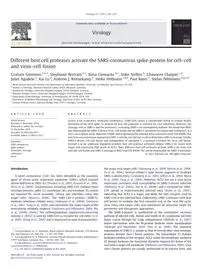
2011 Different host cell proteases activate the SARS-coronavirus spike-protein for cell_cell and virus_cell fusion PDF
Preview 2011 Different host cell proteases activate the SARS-coronavirus spike-protein for cell_cell and virus_cell fusion
Different host cell proteases activate the SARS-coronavirus spike-protein for cell–cell and virus–cell fusion Graham Simmons a,⁎,1, Stephanie Bertram b,1, Ilona Glowacka b,1, Imke Steffen b, Chawaree Chaipan c,d, Juliet Agudelo a, Kai Lu a, Andrew J. Rennekamp e, Heike Hofmann c,d,f, Paul Bates e, Stefan Pöhlmann b,g,⁎⁎ a Blood Systems Research Institute and Department of Laboratory Medicine, University of California, San Francisco, CA, USA b Institute of Virology, Hannover Medical School, 30625 Hannover, Germany c Institute for Virology, University Hospital Erlangen, 91054 Erlangen, Germany d Nikolaus-Fiebiger-Center, University Hospital Erlangen, 91054 Erlangen, Germany e Department of Microbiology, University of Pennsylvania, PA 19104–6076, USA f Department of Medical Microbiology and Virology, University of Kiel, 24105 Kiel, Germany g German Primate Center, Infection Biology Unit, 37077 Göttingen, Germany a b s t r a c t a r t i c l e i n f o Article history: Received 3 December 2010 Returned to author for revision 21 December 2010 Accepted 24 February 2011 Available online 23 March 2011 Keywords: SARS coronavirus Spike protein Proteolytic cleavage Cathepsin L Furin Severe acute respiratory syndrome coronavirus (SARS-CoV) poses a considerable threat to human health. Activation of the viral spike (S)-protein by host cell proteases is essential for viral infectivity. However, the cleavage sites in SARS-S and the protease(s) activating SARS-S are incompletely defined. We found that R667 was dispensable for SARS-S-driven virus–cell fusion and for SARS-S-activation by trypsin and cathepsin L in a virus–virus fusion assay. Mutation T760R, which optimizes the minimal furin consensus motif 758-RXXR-762, and furin overexpression augmented SARS-S activity, but did not result in detectable SARS-S cleavage. Finally, SARS-S-driven cell–cell fusion was independent of cathepsin L, a protease essential for virus–cell fusion. Instead, a so far unknown leupeptin-sensitive host cell protease activated cellular SARS-S for fusion with target cells expressing high levels of ACE2. Thus, different host cell proteases activate SARS-S for virus–cell and cell–cell fusion and SARS-S cleavage at R667 and 758-RXXR-762 can be dispensable for SARS-S activation. © 2011 Elsevier Inc. All rights reserved. Introduction A novel coronavirus (CoV) has been identified as the causative agent of severe acute respiratory syndrome (SARS), which claimed almost 800 lives in 2002–03 (Drosten et al., 2003; Ksiazek et al., 2003; Peiris et al., 2004). Coronaviruses, including SARS-CoV, harbour three envelope proteins, spike (S), membrane (M), and envelope (E), which are required for virion assembly, release and infectious entry into target cells (Masters, 2006). The SARS-CoV-S-protein (SARS-S) mediates infectious cellular entry (Hofmann et al., 2004b; Simmons et al., 2003; Yang et al., 2004) and constitutes the major target of the neutralizing antibody response (Hofmann and Pöhlmann, 2004; Nie et al., 2004b, 2004a). The carboxypeptidase angiotensin-converting enzyme 2 (ACE2) is used by SARS-CoV as receptor for cell entry (Li et al., 2003; Wang et al., 2004) and is expressed on type II pneumocytes, the major viral target cells (Hamming et al., 2004; Mossel et al., 2008; To et al., 2004). Several cellular C-type lectins augment or facilitate SARS-S-driven entry (Gramberg et al., 2005; Jeffers et al., 2004; Marzi et al., 2004; Yang et al., 2004). However, ACE2 but not C-type lectin expression correlates with susceptibility to SARS-S-driven infection (Hofmann et al., 2004a; Nie et al., 2004b) and is essential for SARS- CoV spread in experimentally infected mice (Kuba et al., 2005), indicating that ACE2 is a major and likely the only receptor used by SARS-CoV in the infected host. Collectively, SARS-S interacts with host cell factors to mediate the first essential step in the viral life cycle, virus entry into target cells, and constitutes an attractive target for preventive and therapeutic approaches. The SARS-S-protein is synthesized in the constitutive secretory pathway of infected cells. Amino acid motifs in its cytoplasmic tail slow down transit through the Golgi compartment (McBride et al., 2007) where interactions with the M-protein facilitate virion incorporation (McBride and Machamer, 2010; Voss et al., 2009). The structural organization of SARS-S is similar to that of several other viral envelope proteins, termed class I fusion proteins: The extracellular S1 domain facilitates binding to the receptor, ACE2, while the membrane-anchored S2 domain harbours the functional elements required for fusion of the viral with a target cell membrane (Hofmann and Pöhlmann, 2004). Viral class I fusion proteins are usually synthesized in an inactive form, and Virology 413 (2011) 265–274 ⁎ Correspondence to: G. Simmons, Blood Systems Research Institute, 270 Masonic Ave, San Francisco, CA, USA. Fax: +1 415 567 5899. ⁎⁎ Correspondence to: S. Pöhlmann, German Primate Research Center, Kellnerweg 4, 37077 Göttingen, Germany. Fax: +49 551 3851 184. E-mail addresses:
